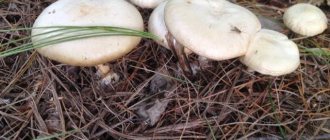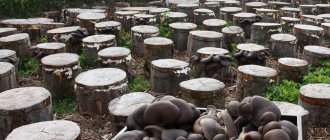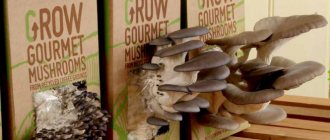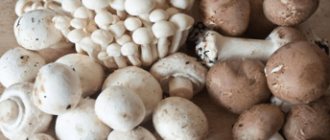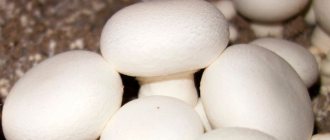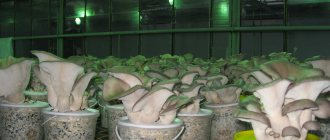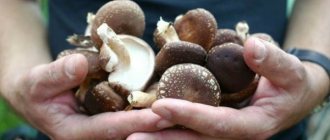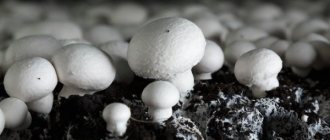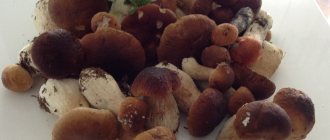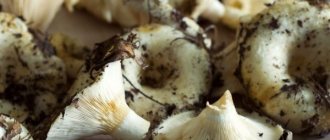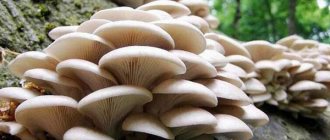Mushroom lovers living in rural areas look forward to the onset of the “quiet hunt” every year, when they can get out into the forest, collect the “harvest” and independently prepare boletuses, boletuses, chanterelles, milk mushrooms, saffron milk caps, honey mushrooms, aspen mushrooms and other tasty treats. a year ahead.
But residents of megacities, alas, mostly have to be content with store-bought products or seasonal markets. Only fresh mushrooms have been sold there for only a few months, and the forest products are quite expensive.
That’s why many city dwellers are thinking about the possibility of growing mushrooms in their own apartments—even if not the fragrant white ones with boletus mushrooms, but “cultivated” species that are more neutral in taste, but still. And this is quite real! Moreover, you will receive harvest all year round, regardless of the weather and time of year outside the window.
For example, the cultivation of champignons dates back to the 17th century.
Of course, no one is forcing you to convert your living space into a mushroom kingdom, but if you have a glazed balcony or a small storage room, you can easily start producing various mushrooms at home - most often, champignons, honey mushrooms and oyster mushrooms are grown in apartments, or “overseas” mushrooms, which are actively used in Asian cooking, shiitake.
Of course, to cultivate mushrooms in an apartment, in addition to a small free space, you will also need some knowledge - and we will provide you with it! Write it down.
How to grow champignons?
Today, growing mushrooms has become a fairly profitable and widespread agricultural activity. Growing champignons at home is certainly not an easy task, but it is completely worth it when you get real profits and a fresh homemade product.
Growing mushrooms, especially those that are popular for food, can become a real business for you if you pay enough attention to cultivation and care. In the warm season, as well as in latitudes with mild climates, mushrooms can be grown annually both in open ground and in greenhouse conditions.
All mushrooms are quite capricious regarding light and temperature. Therefore, the optimal growing conditions will be a temperature not lower than +12 degrees. With high humidity of about 80% and complete shade. A huge advantage of mushrooms such as champignons and oyster mushrooms is that they can be grown in a multi-tiered manner, thereby saving space; the basement may be the ideal place.
For mushrooms, it is necessary to prepare a special nutrient mixture from the soil. A mixture of manure, straw or sawdust is quite suitable. This mixture is prepared approximately a few weeks before the mycelium is added to the substrate. The growth and productivity of mushrooms will directly depend on the quality of the soil. At enterprises that grow mushrooms on an industrial scale, about 200 kilograms of straw or finely chopped sawdust are used for half a ton of manure.
To improve the soil and saturate it, it is enriched with ammonium sulfate, and the substrate is stored in a cool, dark place, avoiding direct sunlight on the mixture. The prepared mixture must be stirred every week, adding 20 kilograms of gypsum once and mixing well. After three to four weeks, the mixture for growing mushrooms will be ready.
It will be very convenient to place wooden decks or pallets in a basement or greenhouse; you can pour the soil directly onto the prepared surface, not forgetting to water the substrate from time to time.
If you are new to growing mushrooms, then it is better to purchase material in the form of mycelium in a specialized store. Spore myceliums are sold in special containers; they come from dung and grain. The dung mycelium is divided into equal pieces and placed in the substrate to a depth of about 5 centimeters; it is better to place them in a checkerboard pattern so that the distance between the seedlings does not exceed half a meter. In order to save space.
Grain myceliums are sown a little differently: grains are laid out on a layer of substrate, and then covered with a layer of soil of about 5 centimeters. The optimal temperature for the development and growth of mycelium is considered to be +25 degrees, then after ten days, the temperature should be reduced to 20 degrees, and the surface of the substrate should be covered with an even layer of soil of 3 centimeters. After a week, the temperature is lowered to +16 degrees; in a month you can expect the first champignons.
Tea mushroom
Description
This organism is a so-called medusomycete - a symbiotic structure that includes yeast and acetic bacteria. The former are mushrooms without mycelium, so the name “kombucha”, although partially, justifies itself.
At home, kombuchas are kept in three-liter jars, less often in other containers. When grown industrially, the weight of this organism reaches several centners. From a zoological point of view, kombucha is a film of these microorganisms located on the surface of the water and consisting of several layers.
Kombucha in a jar
The growth of the fungus occurs when it is fed with sugar. Yeast ferments this sugar, breaking it down into less complex components: ethanol and carbon dioxide. Bacteria convert some of the ethanol into vinegar, and the resulting substances are used to form new generations of yeast and acetic acid bacteria. The organism grows from the bottom layer, the topmost is the oldest. The layers located between them are where sugar is converted.
Growing New Kombucha
You need to start with the future habitat of the organism.
For this we need the following components:
- 3 liter glass jar
- gauze or bandage
- fungal membrane
- high concentration tea solution
- granulated sugar
First, the jar is washed and steamed to sterilize. At the same time, strong tea is prepared.
The concentration of tea must be high, so the following composition is recommended:
- 2 heaped teaspoons of tea
- 5 tablespoons sugar
- 1 liter of boiling water
It is best to brew tea from boiled, cooled and brought to a boil again. This is necessary to increase its softness and ensure that it gets rid of microorganisms.
Be sure to remember that pouring sugar directly onto the mushroom is strictly prohibited!
The tea is poured into a three-liter jar and cooled to room temperature. At the same time, there should be no tea leaves or undissolved pieces of sugar in it. After this, a mushroom membrane is placed in the jar and the neck of the jar is closed with gauze or a bandage. Sometimes it is recommended to add 2-3 teaspoons of mother tea solution along with the membrane.
Adding mushroom membrane to tea
The jar is placed in a warm place, protected from direct sunlight and drafts. Recommended temperature range: from +22°C to +25°C. After about 1-2 weeks, the mushroom will have grown enough and will be ready to produce the drink.
Sometimes during this period the mushroom will settle to the bottom; this is normal, since the first few days there is not enough carbon dioxide in the mushroom to hold it on the surface.
Care
The care technique is simple:
- Once every 15-20 days, the mushroom needs periodic washing.
- And once every 2-6 days you need to drain the liquid from it, adding tea to the jar (the recipe for which was given earlier) to the required level.
- The frequency of fluid renewal depends on the air temperature; the higher it is, the faster the fluid is renewed.
- When the bottom layer is separated from the mushroom, it can be replanted.
In an old mushroom, this layer appears again within 5-10 days. The top crust must be removed as it becomes coarser. Once every two months, the mushroom should be washed especially thoroughly, completely changing the liquid in the jar, sterilizing it.
In this case, the upper and lower layers of the mushroom are removed.
Growing honey mushrooms at home
An equally important mushroom variety that is grown by mushroom pickers at home is considered to be honey fungus. Its unpretentiousness and easy care for the mycelium make honey mushrooms a very popular mushroom. The most common way to grow honey mushrooms is to breed them in wooden tubs. This growing method is widespread because it can be used both on a personal plot and on specially prepared forest land. The main advantage of growing honey mushrooms is their low financial cost, as well as the ease of propagation of mycelium. Growing honey mushrooms in wooden tubs is mainly done by amateur mushroom pickers.
Almost any variety of honey mushrooms is suitable for breeding honey mushrooms at home. The seating area can be wooden logs, tubs, or troughs made of hardwood. But coniferous tree species are not used in growing mushrooms, as they can cause bitterness in the grown product due to the high resin content. Growing honey mushrooms is a fairly simple procedure, and differs little from the cultivation of other myceliums. The procedure for cultivating honey mushrooms itself involves infecting the wood platform with mycelium or planting raw materials.
It is necessary to make cuts in the thickness of wooden containers for planting or drill holes, and then fill the recesses with mycelium or planting material. After the procedure of filling with mycelium, the holes are covered with the prepared substrate. The most simplified option for growing honey mushrooms is to fill a rotten stump with mycelium by infecting the bark and crevices, and then sprinkle it with rotted manure mixed with straw in a 1:1 ratio.
Monitor the quality of your planting material, since it is difficult to acquire high-quality mycelium or mycelium. For home growing honey mushrooms, grain mycelium, which is purchased in specialized stores, is perfect. Also, a fairly common option for seeding material is pieces of wood infected with spores.
Infected wood can be found in the forest yourself and recognized by a white coating, as well as a specific mushroom smell. Such myceliums are carefully removed using a knife or file, divided into pieces, and introduced into prepared cracks in prepared stumps. Before removing forest mycelium, make sure that the mushrooms are edible.
After the completed procedure with the introduction of mycelium, to accelerate the development of the mycelium, the mushroom plantation can be isolated with cellophane, and with proper care, the honey mushroom harvest can be obtained by autumn. Climatic and other factors (such as the quality of the mycelium, humidity and wood) directly affect the rate of growth and development of honey mushrooms. The mushroom harvest will not immediately please you with its abundance.
When growing mushrooms on your site, take into account the fact that mycelium and fungal spores can have a detrimental effect on tree roots, as well as wooden structures. Therefore, exclude the possibility of infection of fruit trees with fungal spores. After the mycelium has been introduced into the soil, fruiting of the mycelium will last about 6 years. Mushroom plantations are quite aggressive, so it is better to fence them off with grooves filled with sand so as not to harm garden plants.
With the growing popularity of mushroom farms, mushroom sticks have also become widely known. Special wooden sticks infected with fungal spores. The ease of working with such raw materials cannot but rejoice; the sticks are simply inserted into tree bark or holes, and then covered with wet sawdust or small straw. This method of growing honey mushrooms is suitable for a garden plot, but in industrial enterprises, only grain mycelium is used for growing honey mushrooms.
Reviews
Grigory 45 years old, Rostov
I really liked the method of growing porcini mushrooms and chanterelles on my plot. It’s not particularly clear through which attachment the mushrooms are rolled into the meat grinder, probably with large holes. I will definitely collect forest soil and water it with mushroom spores.
Stepan 50 years old, St. Petersburg
When growing mushrooms on stumps or logs, do not forget about snails; they destroy the mycelium before you know it.
Elena 43 years old, Volgograd
I would like to clarify that growing oyster mushrooms on sunflower husks is quite an interesting option. When buying mushrooms at the market, I saw that the husks were stuck to them. And the mushrooms tasted very good.
Natalya 32 years old, Chelyabinsk
Be sure to try planting mushrooms in a flower pot or bucket at home! The result will please you!
Growing oyster mushrooms at home
Another common mushroom with excellent taste is the oyster mushroom. There are quite a few ways to grow oyster mushrooms. This article will describe a method that is suitable for both hobbyists growing mushrooms in small batches and for large-scale production. In wild natural conditions, oyster mushroom grows on stumps and deciduous trees. The optimal temperature for the development of mycelium is +25 degrees. Then, at a temperature of +14-16 degrees, fruiting begins, for up to 5 weeks. The sizes of oyster mushrooms range from 5 centimeters to 30, the color of the mushroom is gray, with a brown tint. Oyster mushroom is a fairly aromatic mushroom with good taste. These mushrooms are also suitable for pickling and pickling, as well as frying and making soups.
So, the substrate for growing oyster mushrooms must be prepared in advance. A mixture of sawdust, small straw and sunflower husks will serve for it. The substrate must be clean, without the presence of foreign objects; in addition, it is better to boil the sawdust before preparing the soil to destroy harmful microflora. Afterwards, the substrate is dried on film, spread out in a thin layer.
Temperature and humidity are important for growing mushrooms, so the room must be equipped with everything necessary, clean and well ventilated. Oyster mushroom grows well in basements equipped with heating appliances, hoods and lighting.
You can start planting mycelium after meeting all the necessary conditions for growing mushrooms, namely after preparing the substrate and premises. Oyster mushroom mycelium can be purchased at specialized enterprises and farms, as well as in gardening stores.
You can start sowing after the substrate has been placed at the bottom of ordinary plastic bags or bags, then on a layer of 8 centimeters, the mycelium of 3 centimeters is laid out, broken into pieces, and covered with substrate on top, and so on, one by one, to the top. The bag is bandaged, the contents are compacted, then cuts are made on the bag at a distance of 2-3 centimeters for further growth of mushrooms and removal of excess moisture.
Bags filled with mycelium are placed vertically, about half a meter apart, to allow oyster mushrooms to grow. It will be easier if the bags are formed in such a way that the location of your mushroom “bed” does not cause you any inconvenience later. You should be able to move freely between bags for ease of watering and harvesting. You can arrange the bags in tiers if the room is high enough, which will increase the cultivation area.
The optimal temperature in the room is considered to be 19-25 degrees, when the mycelium begins to develop, the contents of the bags will turn white, as the spores will penetrate deeper into the substrate. Watering bags with mycelium is done once a day. If you comply with all the requirements when cultivating myceliums, then within three weeks, your mushroom bed will delight you with the first fruits.
In order for mushroom fruiting to develop actively, some mushroom gardeners resort to tricks. To do this, the substrate germinated with mycelium is stimulated with a low temperature from +3 to +6 degrees, this temperature is maintained for about two or three days, then you need to leave the substrate in bags, making fairly wide holes there, or remove the substrate and leave it without bags and not water it for a week. After a week-long lack of moisture, the substrate is watered abundantly with water at room temperature, and then once a day, ventilate the room with mycelium, the air temperature in the room should be +15 degrees.
For the first week, your mycelium does not need lighting, but then it is necessary to organize sufficient bright artificial lighting above the bags with mycelium. After the mycelium begins to bear fruit, a new harvest of mushrooms can be obtained every three weeks, however, over time, productivity will decrease, which will serve as a signal to replace the substrate and introduce a new batch of mycelium, that is, to restart the cycle.
From every 100 kilograms of substrate, experienced mushroom pickers receive about 50 kilograms of fresh mushrooms. It is very important, before the start of a new cycle of fruiting of the mycelium, to disinfect the room in order to get rid of the pathogenic environment of the predecessors. The approximate number of cycles per year will be 4-7, depending on care and growing conditions.
Buying mushroom mycelium - choosing a quality product
The choice of the vegetative body (mushroom mycelium) should be approached very carefully. It is worth studying the label and markings in detail, determining the strain, percentage and rate of germination, shelf life and resistance to fungal infections.
It is better to use grain mycelium: when fresh, it should not have a characteristic ammonia odor or black or gray spots on the surface. The presence of these signs indicates fungal deposits. A high-quality vegetative product has a yellowish-orange hue, which differs depending on the variety.
The purchased material must be stored at a temperature of 3-4 degrees, on clean shelves in the cellar or in the refrigerator. In such conditions it can be stored for 6 to 9 months.
Before planting, the bags with mycelium are carefully laid out on shelves for 1-2 days so that they rest and reach room temperature. Then they are lowered into the basement for a day, in the same place where the prepared substrate is stored. This is necessary so that the vegetative bodies do not experience thermal shock due to a sharp change.
The bags should not be adjacent to each other for better air circulation, and the hood should work in the room. After this, it is unpacked, crushed and planted.
Growing porcini mushrooms in the garden
Growing porcini mushrooms in personal plots is not a painstaking procedure and is quite simple. Therefore, it is becoming increasingly popular. If you don’t want to spend money on buying mycelium, then you can do without it, just find the mycelium and the place where porcini mushrooms grow. You can collect mature mushrooms and prepare your own mixture with porcini mushroom spores.
To do this, mature porcini mushrooms are crushed and filled with clean water, left in a dark place for a day. Thus, a solution will be obtained containing numerous spores of the white fungus. Next, you need to follow the plan, choose a dark place, preferably under deciduous trees, and organize something like a garden bed. To do this, we fertilize the ground with rotted manure mixed with chopped straw or sawdust, mix everything thoroughly with the soil, mix it, level it and water the prepared soil with the prepared mixture. It must be taken into account that porcini mushrooms enter into symbiosis only with deciduous trees, and do not like the scorching sun.
Another way to grow porcini mushrooms is to remove the mycelium from the old place and move it to your own plot. The main thing is to properly organize the place for planting the mycelium. Pay attention to what trees the mycelium grew under in a forest or clearing, and the structure of the soil; this will help to establish fruiting in the future on your site.
So, after removing the mycelium, collect enough soil from this place so that it is enough to add to the soil on the site after laying the mycelium. We loosen the soil, fertilize it with manure, pour out the brought soil, and loosen it again. Then we make depressions in the prepared soil and lay out pieces of mycelium, sprinkling it on top with a mixture of sawdust, straw, sunflower husks or forest soil, then lightly moisten it. The myceliums should not be filled with water, and the soil should not be allowed to dry out, that is, the place where porcini mushrooms grow must be constantly moistened.
Mature parts of porcini mushrooms can also be used as seed material. Porcini mushrooms must be chopped, the soil loosened, fertilized with compost and crushed hardwood sawdust. Planting is carried out as in the previous version, only crushed mushroom is added. Then the soil is moistened and sprinkled with chopped straw on top.
Both fresh mushrooms and slightly dried ones will do; these mushrooms are laid out in a dense layer on the prepared soil and watered every day; after the soil becomes infected with spores, the mushrooms can be removed. With proper selection of the place for planting porcini mushrooms and compliance with fertilization and planting technologies, the harvest will appear next year. Reproduction will occur progressively, from a few mushrooms to entire mushroom families, and in another year you will be able to get about two kilograms of porcini mushrooms from your mushroom plantation.
These methods of breeding and growing porcini mushrooms are suitable only for amateur mushroom growers. The described growing methods are widely used in areas where the necessary mushrooms grow in sufficient quantities. Industrial production of porcini mushroom is established mainly in Poland. But our domestic producer does not stand aside, increasing the volume of mushroom production.
Unfortunately, in our time, mushroom cultivation technologies lag behind world producers, although previously mushrooms were bred on an industrial scale in Russia. Today, mushroom cultivation is rather an amateur activity, undoubtedly profitable. The price coefficient on supermarket shelves is quite high, but mushroom cultivation on an industrial scale is not yet practiced in our country at the proper level, preferring to import foreign mushrooms.
If you want to grow porcini mushrooms, it is worth considering the fact that their mycelium differs from other varieties in that it grows together with the roots of trees, forming a kind of symbiosis, and without it the development of the mycelium is not possible. Therefore, the cultivation of porcini mushrooms should take place near the trees growing on your site. It’s even better to organize your own mushroom farm in the adjacent forest belt.
Mycelium propagation
The mycelium is grown in a special substrate. It is necessary to ensure that its structure does not differ much from the natural one. The composition is selected based on the type of mushrooms being grown. For example, shiitakes feel more comfortable in sawdust, champignons take root better in compost, and oyster mushrooms love the straw mixture.
With proper care, crushed straw and sawdust guarantee a good harvest season for any variety of mushrooms listed above.
But it is very important that the substrate is of impeccable quality. It should be dry, not moldy, not smell bad and not contain foreign chemicals.
How to grow chanterelles at home?
Breeding chanterelles, like other mushrooms, is based on the basic rules of mushroom cultivation. Planting a mushroom next to a tree is done using a spore infusion, pieces of mycelium or seed material, with the assistance of a layer of forest soil. The composition of forest soil is rich and nutritious, and the upper humus layer is responsible for the development of mycelium. The bulk of the soil is rich in microelements and organic compounds; it also contains fungal spores, from which fruits then grow. Therefore, when growing chanterelles on your site and preparing myceliums for planting, choose a place where their main population is concentrated, cut off the mushrooms, carefully remove the mycelium and, together with the soil, transfer it to your site.
The removal of forest soil should be carried out near trees; the optimal time for harvesting is considered to be the beginning of autumn or early spring. Layers of soil at least 20 centimeters thick are dug out. In the area where the soil is infested with chanterelles, the bottom layer of forest soil is used. The organization of a mushroom mini-farm should take place in a cool, shaded place, among trees. We bury the mycelium in the ground and sprinkle it with chopped straw. Maintain proper humidity.
If you previously noticed a place where a lot of chanterelles grow, mark this place. However, the absence of mushrooms cannot guarantee that the mycelium is dead, it is simply possible that the season was less fruitful; the main criterion should be that the mushrooms were previously noticed in this place. Fungal spores remain in the soil for a long time and are not afraid of bad weather and suppression of fruiting. They continue to exist remarkably well, using a minimum of nutrients, taking advantage of their protection.
In order for forest soil to serve as good soil for a future mushroom farm, it must undergo a certain stage of preliminary preparation. This preparation method will improve the quality of forest soil. To properly prepare forest soil, it is packaged in plastic bags and dried in a cold room, the main thing is to leave oxygen access to the soil. The soil can be stored in such conditions for up to a year, without harming fungal spores, but pathogenic microorganisms will die without moisture. As a result of this kind of training, the mushroom spores will get used to drought conditions and become more resilient.
It is better to plant chanterelles on the site in early spring; increased humidity and warm weather will contribute to better implantation of the mycelium into the soil and its further development. Previously harvested forest soil must be mixed with garden soil in a 1:1 ratio, pour the soil mixture into the prepared depressions, add mycelium or a prepared chanterelle solution there, and cover it with fine straw or rotted leaves on top to protect the mushroom bed from drying out.
Watering must be organized in such a way as not to harm the mycelium; it is better to water in small portions, slightly moistening the soil, because water stagnation should not be allowed. The mycelium can simply die from excess moisture as a result of rotting.
Chanterelle has not yet become widespread, although it has an excellent taste and contains quite a few useful substances. Only a few mushroom gardeners grow chanterelles on their plots. However, it is quite possible that chanterelles will soon prove themselves and the mushroom industry will turn its attention to these mushrooms. And we can all be content with tasty and healthy mushrooms that can even treat gastrointestinal diseases.
On the windowsill
25 mushroom species grow under artificial conditions. Most of them can be grown in a city apartment. The main thing is to create the necessary microclimate. The easiest way to grow honey mushrooms is on a windowsill, but you can also try chanterelles and boletus mushrooms.
Oyster mushrooms are the most unpretentious, but for their cultivation it is better to use separate rooms, for example, pantries, since the spores of these mushrooms can cause allergies. And for champignons, the nutrient mixture gives off an unpleasant odor.
If you decide to plant a plantation on a windowsill, the windows should be on the west or north side to avoid direct sunlight. Windows facing a glazed balcony or loggia are not suitable - there will be difficulties with ventilation and temperature regulation.
Popular methods of “window sill” growing mushrooms:
- in glass and plastic jars;
- in pots or containers;
- in mycelium boxes.
The easiest method is to buy a mycelium box for breeding. It contains a nutrient medium with already grown mushroom filaments. You can also purchase ready-made mycelium and prepare the soil mixture yourself.
Growing shiitake mushrooms at home
Unpretentious, easy to grow and very healthy shiitake mushroom, it is very popular in foreign countries. Foreign industrial companies grow this mushroom in huge quantities. And for good reason. In terms of beneficial properties, the mushroom is not inferior to its relatives; it strengthens the nervous system and has a tonic effect. It contains the optimal amount of amino acids for humans.
Traditional places for growing shiitake mushrooms are tree stumps and logs. In the land of the rising sun, this mushroom is very popular. In our country, shiitake mushrooms are grown on sawdust from deciduous trees. The largest harvests can be obtained if these mushrooms are grown on an enriched, specially prepared substrate, which is formed into blocks and infected with mycelium.
The main component of the substrate for growing shiitake is beech, birch, oak, and ash sawdust, enriched with special fertilizers. Sawdust from coniferous trees is not suitable for growing. The content of esters and resin substances in them will have a disinfecting effect and only hinder the development of mycelium. The size of sawdust also plays an important role in growing mushrooms.
Since too small ones will clump together and disrupt aeration, slowing down the growth of the mycelium. Sawdust can be mixed with wood chips for better gas exchange. In order for shiitake mushrooms to please you with a harvest, the soil must be sterilized before colonizing the mycelium. The fact is that the mycelium of shiitake, like all other mushrooms, develops more slowly than pathogenic microorganisms that can harm the mycelium in the future and leave you without a mushroom harvest.
The substrate infected with mycelium should not be too wet or dense; a bacterial infection will develop in such soil. The substrate for industrial production of shiitake is stored in bags, then sterilized and used for its intended purpose. However, there are other methods of preparing the substrate yourself.
It is not difficult to prepare the substrate; the sawdust is sterilized by heat treatment, cooled, dried, then seeded with mycelium, and then packaged in plastic bags. Thus, the mycelium develops in a warm temperature, the mycelium grows for a month and a half, and then the contents of the bags are taken out and mushroom beds are formed in the basement or other room intended for growing mushrooms.
The entire process of packaging and contamination of soil with mycelium must be carried out in compliance with sanitary standards. Fruiting on open formed blocks lasts about six months.
The cultivation time for shiitake mushrooms in compliance with the thermal treatment of the soil, be it sawdust or other substrates intended for this purpose, is shorter than real outdoor cultivation. This method of growing mushrooms is called intensive; harvesting, subject to all the requirements of this method, occurs year-round, in specially designated areas indoors.
To increase the development time of mycelium, special fertilizers and enriching additives are added to the soil. Sources can be elements of organic origin and nitrogen-containing ones. You can freely purchase ready-made additives for growing mycelium and increasing shiitake fruiting in specialized stores, or you can use compost or rotted manure.
To increase the level of acidity, as well as for the purpose of enrichment, in addition to organic matter, a dose of mineral fertilizers is added to the substrate, in the form of crushed chalk, bone meal, gypsum, or ready-made ones purchased in the store.
What should you pay attention to when purchasing a substrate?
Planting material should be purchased at trusted specialized retail outlets. Preference should be given to sawdust, which contains fungal spores - they are more resistant to disease.
Also, a sawdust substrate is much more fruitful than others, because it allows the root system of fungi to take root and spread better.
How to properly dry mushrooms at homeHow to store mushrooms - norms, rules, optimal conditions, how to properly grow, process and store mushrooms (100 photos)
Growing honey mushrooms - 95 photos and video description of the technology for growing the main species at home
Conditions
For successful cultivation, you should prepare a basement or greenhouse with a high level of humidity. You should avoid structures made of wood, as at this level of moisture they will simply collapse.
The temperature should be in the range from 14 to 22 degrees. Mushrooms are not picky and therefore caring for them consists solely of regular watering.
